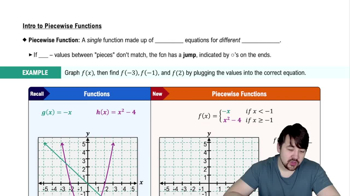Derivative of multiples Does knowing that a function g(t) is differentiable at t = 7 tell you anything about the differentiability of the function 3g at t = 7? Give reasons for your answer.
Table of contents
- 0. Functions7h 54m
- Introduction to Functions16m
- Piecewise Functions10m
- Properties of Functions9m
- Common Functions1h 8m
- Transformations5m
- Combining Functions27m
- Exponent rules32m
- Exponential Functions28m
- Logarithmic Functions24m
- Properties of Logarithms36m
- Exponential & Logarithmic Equations35m
- Introduction to Trigonometric Functions38m
- Graphs of Trigonometric Functions44m
- Trigonometric Identities47m
- Inverse Trigonometric Functions48m
- 1. Limits and Continuity2h 2m
- 2. Intro to Derivatives1h 33m
- 3. Techniques of Differentiation3h 18m
- 4. Applications of Derivatives2h 38m
- 5. Graphical Applications of Derivatives6h 2m
- 6. Derivatives of Inverse, Exponential, & Logarithmic Functions2h 37m
- 7. Antiderivatives & Indefinite Integrals1h 26m
- 8. Definite Integrals4h 44m
- 9. Graphical Applications of Integrals2h 27m
- 10. Physics Applications of Integrals 3h 16m
- 11. Integrals of Inverse, Exponential, & Logarithmic Functions2h 31m
- 12. Techniques of Integration7h 41m
- 13. Intro to Differential Equations2h 55m
- 14. Sequences & Series5h 36m
- 15. Power Series2h 19m
- 16. Parametric Equations & Polar Coordinates7h 58m
2. Intro to Derivatives
Differentiability
Problem 3.2.44
Textbook Question
In Exercises 41–44, determine whether the piecewise-defined function is differentiable at x = 0.
g(x) = { 2x − x³ − 1, x ≥ 0
x − (1 / (x + 1)), x < 0
 Verified step by step guidance
Verified step by step guidance1
First, ensure the function is continuous at x = 0. Evaluate the left-hand limit and the right-hand limit of g(x) as x approaches 0, and check if they are equal to g(0).
Calculate the right-hand limit: For x ≥ 0, g(x) = 2x - x³ - 1. Evaluate the limit as x approaches 0 from the right: lim (x -> 0+) (2x - x³ - 1).
Calculate the left-hand limit: For x < 0, g(x) = x - (1 / (x + 1)). Evaluate the limit as x approaches 0 from the left: lim (x -> 0-) (x - (1 / (x + 1))).
Check if the left-hand limit and the right-hand limit are equal. If they are, the function is continuous at x = 0.
To determine differentiability, calculate the derivative of each piece of the function and evaluate the left-hand and right-hand derivatives at x = 0. If these derivatives are equal, the function is differentiable at x = 0.
 Verified video answer for a similar problem:
Verified video answer for a similar problem:This video solution was recommended by our tutors as helpful for the problem above
Video duration:
6mPlay a video:
Was this helpful?
Key Concepts
Here are the essential concepts you must grasp in order to answer the question correctly.
Piecewise-Defined Functions
A piecewise-defined function is a function composed of multiple sub-functions, each applying to a specific interval of the domain. Understanding how these sub-functions interact at their boundaries is crucial, especially when determining continuity and differentiability at points where the function's definition changes.
Recommended video:

Piecewise Functions
Continuity at a Point
For a function to be differentiable at a point, it must first be continuous there. Continuity at a point x = c means that the left-hand limit, right-hand limit, and the function's value at c are all equal. This ensures there are no jumps or breaks in the graph of the function at that point.
Recommended video:

Intro to Continuity
Differentiability and Derivatives
A function is differentiable at a point if it has a defined derivative there, meaning the function's graph has a tangent line at that point. This requires the left-hand and right-hand derivatives to be equal. Differentiability implies continuity, but a continuous function is not necessarily differentiable if it has a sharp corner or cusp at the point.
Recommended video:

Finding Differentials

 5:02m
5:02mWatch next
Master Determining Differentiability Graphically with a bite sized video explanation from Patrick
Start learningRelated Videos
Related Practice
Textbook Question
